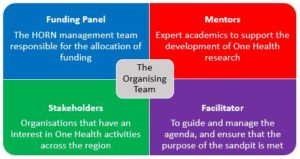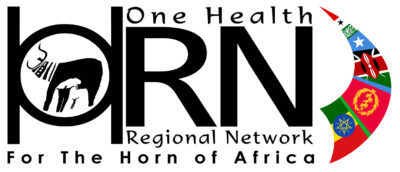29th September – 3rd October
Nairobi, Kenya
The application process has now closed. Applicants will be notified whether they have been awarded a place by the middle of August 2019.
We are pleased to announce the second HORN Sandpit event. The focus for this event is the United Nations’ Sustainable Development Goal 3, “Good Health and Well-Being”.
What is a sandpit?
The purpose of a sandpit is to generate research ideas and high quality research proposals, through a 5 day event that encourages networking, collaborative working and interdisciplinarity. Research ideas generated through a sandpit should have impact within the Horn of Africa region by responding to national (and regional) priorities using a One Health approach. Sandpits provide an opportunity for participants to develop, refine and present research ideas. As part of the event, you will be provided with lectures and guided learning around One Health, ethics, grantsmanship, and how to present research proposals.
| Day 1 Sunday 29th September |
‘Network’ Informal opportunity to meet mentors and peers |
| Day 2 Monday 30th September |
‘Clarify & Conceive’ Consider initial research ideas and learn more about One Health |
| Day 3 Tuesday 1st October |
‘Collaborate & Create’ Develop project ideas collectively in groups with peers and mentors |
| Day 4 Wednesday 2nd October |
‘Develop & Prepare’ Grow ideas into projects, and learn how to pitch proposals in groups |
| Day 5 Thursday 3rd October |
‘Pitch’ Project teams to present their proposals to the funding panel. |
Alongside participants who attend the sandpit, there is a team to support you to develop research projects:

About HORN
The One Health Regional Network for the Horn of Africa (HORN) project is an interdisciplinary, collaborative partnership of the University of Liverpool (UK), Liverpool School of Tropical Medicine (UK), International Livestock Research Institute (Kenya & Ethiopia), the University of Nairobi (UoN), Addis Ababa University (AAU), Hamelmalo Agricultural College (Eritrea), iGAD Sheikh Technical Veterinary School (Somaliland) and Amoud University (Somaliland).
One Health is the concept that the health and well-being of people is linked to the health of their animals and the environment. It is nowhere more true than in the Horn of Africa where many people’s livelihoods are highly, or in some cases entirely, dependent on livestock. Animals are culturally, socially and economically vital in the region. Livestock provide, for example, over 60% of agricultural GDP in the Horn, but can also be a source of human disease. Outbreaks of disease in animals thereby directly affect people’s health, but also their wealth and nutrition.
Livestock production and human health and wellbeing in the Horn of Africa can be increased through research, leading to improved agricultural systems; more food and less malnutrition; more financial resilience; and better detection, diagnosis, prevention and control of disease.
HORN’s mission is to improve the health and wealth of the people of the Horn of Africa by increasing the local capacity to undertake high quality research in the interactions between people and animals – One Health.
Eligibility
1. Researchers at all levels are eligible to participate in a HORN sandpit, but we especially welcome applications from early career/junior researchers
2. Research projects are co-created and developed at the sandpit event. Therefore, we will not be funding research projects that have already been developed prior to the event
3. Applications are open to researchers from Kenya, Ethiopia, Eritrea, Somaliland and Somalia
4. We particularly encourage applications from women
5. Applicants from a wide range of backgrounds are welcome to apply, including (but not limited to): microbiology, economics, data scientists, public health, medicine, veterinary medicine, epidemiology, zoo-archaeology, vector biology, anthropology and social science
6. Attendance at the full five days is required, and please ensure you are able to attend all five days before you apply
Information for Applicants
Through this Sandpit event, all participants who successfully obtain funding for research projects will become HORN Research Fellows, and those who attend but are unsuccessful in obtaining research funding will be invited to become HORN Training Fellows. All fellows will be able to access HORN e-learning materials, and HORN research fellows will be invited to training events, including summer schools and One Health masterclasses. You will also be supported throughout your research projects by expert mentors.
Field Sites and Research Areas
As part of the application process you will be asked to select which country, research site and research project idea/area you are interested in. You can choose up to a maximum of three sites & research areas. At the sandpit you will develop these ideas collaboratively in groups & teams using a One Health approach. On the last day of the event you will then pitch your project to the funding panel, and you will be notified the same day whether you have been successful.
1. Maekel, Debub, Anseba, & Gash-Barka Regions, Eritrea
Maekel Region (also known as Central Region) is the administrative region in central Eritrea; it contains the countries capital city Asmara. As the administrative centre for the country, the main economic activities of the region are sales, domestics services and professional and managerial employment. Debub Region (also known as Southern Region) lies along a portion of the national border with Ethiopia, and Anseba Region is located in Northern Eritrea bordering Sudan. The main economic activity in both regions is agriculture. Gash-Barka Region is situated in the south-west of the country (Sudan lies to the west and Ethiopia to the south), and whilst the main economic activity in the region is agriculture, a large number of people are also employed in sales and services.
Research areas:
– Surveillance of zoonotic diseases at slaughterhouses (all regions)
– Bovine tuberculosis and brucellosis at animal and human interface (Maekel & Debub regions)
– Role of environmental mycobacteria (nontuberculous mycobacteria) in animal and human diseases (all regions)
– Hydatidosis in municipal slaughterhouses and humans in Eritrea (Anseba & Gash Barka regions)
2. Butajira Gilgil Gibe, & Kilite Awlaelo HDSS, Ethiopia, Ethiopia
Butajira, Gilgil Gibe and Kilite Awleolo are part of Health and Demographic Surveillance (HDSS) network in Ethiopia and are major sources of longitudinal data on humans. Butajira is located in Guraghe Zone, Southern Nations Nationalities and People’s Region. Gilgel Gibe HDSS is located surrounding the Gilgel Gibe Hydroelectric dam, in Jimma Zone, Oromia Region, southwest Ethiopia. Kilite Awleolo HDSS is located in Eastern zone, Tigray Region, northern Ethiopia. All sites include rural and urban districts and have the benefit of a strong existing infrastructure for community-based research. Projects can occur in 1 or more of these sites (i.e. multi-centre study).
Research areas:
– Approaches to integrated (human, animal, environment) surveillance
– Zoonoses knowledge, attitudes and practices
– Climate change and health (human and animal)
– Antimicrobial resistance and its prevention
3. Bishotfu, Ethiopia
Bishoftu (Debre Zeyit) is located in East Shewa Zone, Oromia Region, central Ethiopia, around 50km from Addis Ababa. Approximately 25% of the population of East Shewa Zone reside in urban areas. Bishoftu is the location of the AAU College of Veterinary Medicine and National Veterinary Institute, and associated laboratories.
Research areas:
– Investigations into priority zoonoses (rabies, brucellosis, leptospirosis, echinococcosis; excluding anthrax) and food safety.
– Antimicrobial resistance and its prevention
4. Busia County, Kenya
Located in the west of Kenya, Busia is the capital and largest town of Busia County. Being a cross-border centre, the main economic activity is trade with neighbouring Uganda, but away from town the county economy is heavily reliant on fishing and agriculture. The small-holder, crop-livestock production system in Busia characterises the western region of Kenya close to Lake Victoria. Multiple research questions can be proposed for this site, which benefits from a well-equipped field laboratory, and which can also host activity focussed in the field in Siaya County, the location of the Yala Swamp ecosystem.
Research areas:
– Burden of disease due to acquired epilepsy
– Structure of, and risks within, food value chains
– Social and economic acceptability of control options for porcine cysticercosis
– Characterising microclimatic change in relation to arbovirus disease transmission
5. Kajiado County, Kenya
Bordering Tanzania in southeastern Kenya, Oloitoktok is a small but growing town. The region is a semi-arid zone with a predominantly pastoralist livestock production system. It also has a field laboratory supported by the HORN project.
Research areas:
– Community led disease prioritisation and risk mapping
– Mobile based syndromic surveillance in humans or animals
– Household socioeconomics and health
6. Laikipia County, Kenya
Laikipia County is semi-arid region located in central Kenya . Economic activity in the county consists mainly of tourism, wildlife conservation and agriculture; chiefly grain crops, ranching and greenhouse horticulture.
Research areas:
– Study of camel health in semi-arid regions of Kenya
– Organisation of vegetable and animal course food systems in a rapidly emerging market town in central Kenya
7. Awdal Region, Somaliland
The Awdal region in Somaliland borders Ethiopia in the North West and South West, and Djibouti and the Gulf of Aden in the North. It consists of four districts: Boroma (the regional capital), Baki, Lughaye, and Zeylac. The major economic activities of the region are pastoralists, agro-pastoralists, fishing and trade including education and health. Livestock is a mainstay of Somaliland economy. More than 60% of the population depends directly or indirectly on livestock products and by-products for livelihood.
Research areas:
– Zoonotic bacterial disease control and knowledge, attitudes and practices
– Immunisation and nutrition among children and mothers
Research Projects
Research projects will be developed during the sandpit, and it’s important to not have pre-defined projects. However, before applying, you should be aware of the following conditions should your project be successfully funded:
-
-
• Research projects are expected to be 3-12 months in duration.
• The cost of each project will vary depending upon the number of researchers in each project team, however we do not expect to fund more than 15-20 researchers, with an approximate financial value of £5,000 to £10,000 (GBP) per researcher.
• Costs are permitted to cover consumables, travel, field costs, subsistence and salary replacement (where necessary). Please note that equipment cannot be covered, except under exceptional circumstances. Further information on budget conditions will be provided at the event.
• Projects should be undertaken at one of the field sites mentioned previously, and you should select your research area of interest on the application form.
• Projects are likely to be developed as teams and groups, and therefore if your project is funded following the sandpit, you will work collaboratively with others to refine and conduct the research study.
• All research projects should be have full local and international ethical approval before commencing, and the time taken to obtain approval should be taken into consideration. You will be supported throughout this process by your mentor/s.
-
To Apply
The application process has now closed.
Applicants will be notified whether they have been awarded a place by the middle of August 2019. The cost of attending the sandpit event will be paid for by HORN.
